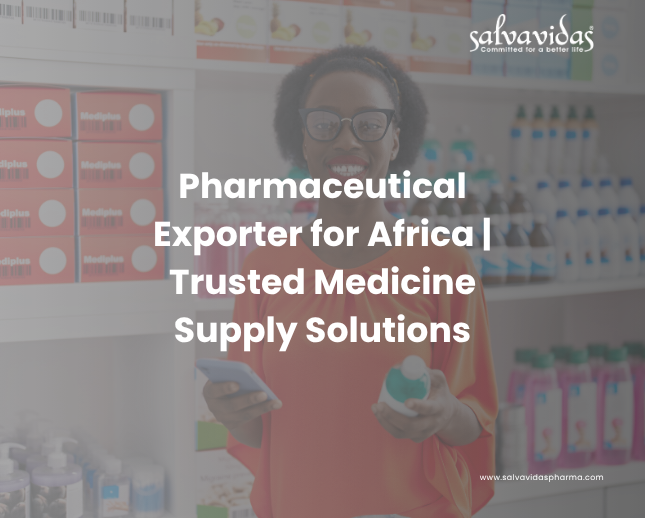
Research and Development in the Pharmaceutical Industry Introduction – Why R&D is the Heart of the Pharma Sector The research and development of pharmaceutical industry is essential to the producing accessible, safe and effective drugs that enhance global wellness. Every innovation is based on research and development (R&D), which propels the long-term sustainability for global healthcare systems as well as the discovery of new compounds and the enhancement of current medications. New innovation guarantees that treatments become more affordable, effective and widely accessible in today’s changing healthcare environment, especially for chronic and emerging disorders. It ensures the highest standards of safety and efficacy while supporting pharmaceutical companies in responding quickly to global health disasters. Companies such as Salvavidas Pharma continue to further this goal by creating R&D-driven compounds that satisfy international regulatory standards and promote improved patient outcomes. Understanding Pharmaceutical Research and Development A number of scientific and technical procedures are used in pharmaceutical research and development to turn a concept into a medication that is ready for the market. This path starts in research labs where scientist investigates novel substances, investigate illness mechanisms and discover possible treatment targets. Usually, the R&D process is broken down into multiple stages: Pre-clinical trials – safety, toxicity and biological activity are assessed by laboratory and animal research. Clinical trials (Phases I–III) – studies on humans that evaluate side effects, safety, effectiveness and dosage. Regulatory approval – data submission for final assessment to organizations like the FDA, EMA or CDSCO. Pharmaceutical R&D is crucial, but it frequently faces obstacles like high operating expenses, complicated clinical trial criteria, long approval timeframes and unpredictable results. However, this stringent procedure guarantees that only safe and efficient medications reach the worldwide market. Drug Discovery and Development – The First Step toward Innovation Drug discovery and development is the core of every innovative treatment. It starts with unmet medical needs, evaluating promising substances and validating their therapeutic potential. This stage is being significantly altered by modern science. High-throughput molecular screening, machine learning and artificial intelligence have made it possible for researchers to increase accuracy, decrease trial failures, and expedite discovery. For example, oncology medications, mRNA treatments and therapies for uncommon diseases developed in recent years demonstrate how R&D innovation can result in life-altering outcomes. Many of these innovations are driven by partnerships with active pharmaceutical ingredients manufacturers, who provide high-quality APIs essential for both early and late-stage drug development. Pharmaceutical Product Development and Manufacturing Process When a drug concept enters pharmaceutical product development, it is developed into injections, capsules, tablets or other dosage forms. This phase requires accuracy and scientific knowledge to make sure the drug is safe, stable and effective in therapy. Important steps include: Formulation development – using the right recipients to create the ideal drug form Stability testing – ensuring that the drug is safe and effective in a variety of situations. Scale-up and technology transfer – shifting from small-scale laboratory production to commercial production for the global landscape. During the pharmaceutical manufacturing process, quality assurance and regulatory compliance are important to make sure that each batch satisfies global quality standards. For reliable, scalable and compliant production, many international companies depend on a reliable Finished Formulation supplier. Driving Pharmaceutical Industry Innovation in 2025 and Beyond The rise of digital technology, sustainable chemistry, specific drug and the inclusion of data-driven healthcare are all affecting the future of the pharmaceutical industry innovation. Notable worldwide trends consist of: Digitalization – AI-driven analytics that speed up R&D and increase the precision of clinical trials. Green chemistry – eco-friendly manufacturing that uses less energy and produces less trash. Precision medicine – customized treatments according to the genetic profiles of the patients. Global innovations are further accelerated by government backing, investment for biotechnology firms and long-term collaborations between academic institutions and private organizations. To provide high-quality formulations that satisfy future healthcare demands, companies like Salvavidas Pharma are embracing cutting-edge technologies, sustainable practices and international partnerships. The Future of Research and Development in the Pharmaceutical Industry The research and development of the pharmaceutical industry is embarking on an exciting new phase. The next wave of treatments, including biologics, cell-gene therapy and nanomedicine, will transform medical science. Future-shaping new developments include: Nanotechnology-based drug delivery, making it possible to target sick cells precisely. Biologics and biosimilars, providing more specific and secure treatment choices. AI-driven discovery, raising the early-stage research achievement rate. Faster clinical testing models, particularly trials with adaptability that reduce study time. Affordable innovation, offering improved access to necessary drugs for poor countries. The significance of research and development increases as the world’s healthcare system develops. R&D guarantees ongoing progress and the preservation of the health of future generations. Conclusion Innovation is the lifeblood of the pharmaceutical sector, and R&D continues to be the engine of life-saving medical discoveries. The pharmaceutical industry’s research and development guarantees that healthcare systems can meet the demands of a world that is changing quickly, from drug discovery to worldwide manufacture. Organizations like Salvavidas Pharma help to close the gap between innovation and accessibility by providing high-quality, scientifically supported formulations to millions of patients globally. The next wave of pharmaceutical discoveries will be made possible by cooperation, funding, and scientific progress, guaranteeing a better, more promising future for all.

Antibiotic Injectable Manufacturer Introduction to Antibiotic Injectables The demand for the best antibiotic injectable manufacturer is rising as hospitals, clinics, and global healthcare systems continue to depend on safe, effective, and fast-acting treatments. Antibiotic injectables play a critical role in fighting severe infections, sepsis, pneumonia, and surgical complications where oral medications are not effective. But what makes a manufacturer the best choice in this highly competitive pharmaceutical industry? Let’s explore in detail. What Are Antibiotic Injectables? Antibiotic injectables are medications administered via injection, typically intramuscularly (IM) or intravenously (IV), to treat bacterial infections. Unlike oral antibiotics, injectables bypass the digestive system, ensuring faster absorption and stronger therapeutic effects. Some common injectable antibiotics include: Ceftriaxone Amikacin Cefuroxime Meropenem Vancomycin These medicines are crucial for life-threatening infections where time is critical. Importance of Injectable Antibiotics in Modern Healthcare Rapid action against severe infections such as meningitis or septicemia. Used in emergency care where oral intake is impossible. Reduces mortality rates in high-risk patients. Backbone of surgical prophylaxis in hospitals. Without reliable manufacturers, global healthcare would face shortages of these life-saving drugs. Global Demand for Antibiotic Injectables Rising Infections and Antibiotic Resistance According to the World Health Organization (WHO), antimicrobial resistance is one of the top 10 global health threats. This drives higher demand for newer and more effective injectables. Growth of Injectable Pharma Market Worldwide The global injectable drugs market is expected to surpass USD 1 trillion by 2030, with antibiotics taking a significant share. Countries like India and China are becoming global hubs due to cost-effective yet high-quality manufacturing. Key Qualities of the Best Antibiotic Injectable Manufacturer Regulatory Compliance & Certifications The best antibiotic injectable manufacturer must hold approvals like: WHO-GMP Certification ISO 9001:2015 FDA Approval (for exports to the US) EU-GMP Certification (for Europe) State-of-the-Art Manufacturing Facilities Modern sterile facilities with cleanroom technology and automated filling systems ensure safety and precision. Research & Development Capabilities A strong R&D wing allows companies to develop new formulations, combat resistance, and ensure global competitiveness. Stringent Quality Control & Testing From raw material sourcing to finished product release, multiple levels of testing guarantee safety and efficacy. Supply Chain and Global Distribution Network The best manufacturers maintain robust logistics networks, ensuring timely delivery worldwide. How to Choose the Right Antibiotic Injectable Manufacturer When selecting a reliable partner: Evaluate the product range: Does the manufacturer cover multiple therapeutic categories? Check safety standards: Compliance with pharmacopoeia standards (USP, BP, IP). Reputation and reviews: Look for proven track records. Transparency: A good manufacturer provides test results, certifications, and open communication. Cost-effectiveness: Balance between pricing and uncompromised quality. Leading Regions for Antibiotic Injectable Manufacturers India 🇮🇳 – Known as the “Pharmacy of the World,” India is home to global exporters like Sun Pharma, Cipla, and Lupin. China 🇨🇳 – Major supplier of active pharmaceutical ingredients (APIs). Europe & US 🌍 – Home to big pharma innovators with advanced research facilities. Future of Antibiotic Injectables Innovation in Drug Delivery Systems Emerging solutions include long-acting injectables, nano-formulations, and pre-filled syringes for better compliance. Addressing Antibiotic Resistance with Next-Gen Solutions Manufacturers are now investing in next-generation antibiotics and combination therapies to outsmart resistant bacteria. FAQs on Antibiotic Injectable Manufacturers Q1: What certifications should the best antibiotic injectable manufacturer have?A1: WHO-GMP, ISO, FDA, and EU-GMP are essential. Q2: Why are injectable antibiotics more effective than oral ones?A2: They provide rapid absorption and stronger therapeutic results, especially in severe infections. Q3: Which country is the leading exporter of antibiotic injectables?A3: India leads globally due to cost-efficiency and strong regulatory compliance. Q4: How can hospitals ensure they are sourcing from reliable manufacturers?A4: By checking certifications, quality audits, and reputation in global markets. Q5: What is the future of antibiotic manufacturing?A5: Innovation in drug delivery, R&D on resistant strains, and personalized medicine. Q6: Are generic antibiotic injectables safe?A6: Yes, if sourced from WHO-GMP certified and regulated manufacturers. Conclusion – Choosing the Best Partner for Healthcare Excellence Finding the best antibiotic injectable manufacturer is crucial for safeguarding global health. Manufacturers that combine quality, compliance, innovation, and affordability will continue to lead the pharmaceutical industry. Healthcare providers, distributors, and governments should prioritize trustworthy manufacturers to ensure a steady supply of life-saving antibiotic injectables worldwide.

Pharmaceutical Exporter for Africa Introduction Africa is one of the fastest-growing healthcare markets in the world. With a population of over 1.4 billion and increasing healthcare needs, the demand for medicines has skyrocketed. This has created a golden opportunity for pharmaceutical exporters for Africa, who play a vital role in bridging the supply-demand gap and ensuring millions of people have access to life-saving drugs. The Pharmaceutical Market in Africa Healthcare challenges remain significant in Africa, ranging from infectious diseases to chronic conditions like diabetes and hypertension. Despite these hurdles, governments are investing heavily in healthcare infrastructure and policies to support wider drug availability. The African pharmaceutical market is projected to grow rapidly, driven by both public healthcare programs and private sector investment. Why Africa is an Attractive Market for Pharmaceutical Exporters Africa’s pharmaceutical demand is driven by: Population growth: By 2050, Africa is expected to double its population. Urbanization: More people living in cities need easier access to pharmacies and hospitals. Disease burden: High prevalence of malaria, HIV, and tuberculosis, alongside rising chronic diseases. Healthcare expansion: Governments and NGOs are improving hospital networks and supply chains. Types of Pharmaceuticals in High Demand Essential medicines: Antibiotics, painkillers, antimalarials. Vaccines: For polio, measles, and COVID-19. Chronic disease drugs: Diabetes, heart disease, and cancer therapies. Generics: Affordable alternatives to branded drugs, extremely popular in low-income regions. Role of Pharmaceutical Exporters Pharmaceutical exporters are the backbone of Africa’s medicine supply chain. They: Fill the gap between local manufacturing and demand. Provide affordable solutions to patients. Build long-term partnerships with hospitals, clinics, and governments. Key African Markets for Pharmaceutical Exporters Nigeria: Largest population in Africa, massive drug demand. South Africa: Well-regulated market with strong private healthcare. Kenya: Gateway to East Africa’s pharma trade. Ghana: Stable economy and growing healthcare investments. Ethiopia: Emerging pharmaceutical market with government backing. Regulatory Requirements for Exporting Pharmaceuticals to Africa Each country has its own drug authority with strict registration rules. Exporters must: Get WHO prequalification for credibility. Secure product registration with local health ministries. Follow Good Manufacturing Practices (GMP). Challenges Faced by Pharmaceutical Exporters Exporting to Africa isn’t without obstacles: Complex regulations: Vary widely by country. Counterfeit drugs: A serious public health concern. Logistics issues: Cold chain management is tough in rural areas. Currency fluctuations: Affect pricing and profitability. Strategies for Successful Pharmaceutical Exporting To succeed in Africa, exporters should: Partner with local distributors for deeper market penetration. Ensure compliance with global and local standards. Research consumer needs and adapt packaging/language. Adopt digital health tools like e-pharmacies and telemedicine. Case Studies of Successful Pharmaceutical Exporters in Africa Indian exporters: India supplies up to 50% of Africa’s generic drugs. European exporters: Focused on branded and specialty medicines. Regional collaborations: Increasing trade within Africa itself through the African Continental Free Trade Agreement (AfCFTA). The Future of Pharmaceutical Export in Africa The future is bright, with trends such as: Local manufacturing: Supported by incentives and joint ventures. Public-private partnerships: Expanding distribution. Digital healthcare: Online pharmacies and telemedicine bridging rural gaps. Sustainability and Corporate Social Responsibility Responsible exporters are focusing on: Affordable pricing strategies to reach low-income patients. Donations and subsidies for essential medicines. Healthcare education programs for communities. How to Choose the Right Pharmaceutical Exporter Healthcare providers and distributors in Africa should look for exporters with: Certifications like WHO-GMP, ISO. Proven track record in African markets. Strong logistics networks for uninterrupted supply. Benefits for African Healthcare Systems Reliable exporters improve healthcare by: Expanding access to essential medicines. Lowering the disease burden. Supporting better health outcomes for millions of people. Conclusion Africa’s pharmaceutical market is a land of opportunities for exporters. By addressing regulatory challenges, focusing on quality, and building sustainable partnerships, exporters can play a crucial role in transforming healthcare across the continent. The future of pharmaceutical export in Africa is not just about business—it’s about saving lives and shaping healthier nations. FAQs Q. What are the top African countries importing pharmaceuticals?A. Nigeria, South Africa, Kenya, Ghana, and Ethiopia are among the largest importers. Q. How do exporters ensure drug quality in Africa?A. By following WHO-GMP standards, securing local registrations, and maintaining cold chain logistics. Q. Are generic medicines popular in Africa?A. Yes, generics dominate due to affordability and wide acceptance in public health programs. Q. What challenges do exporters face in Africa?A. They face issues like complex regulations, counterfeit medicines, logistics difficulties, and currency risks. Q.How can African governments support pharmaceutical exporters?A. By simplifying regulations, investing in infrastructure, and encouraging partnerships with global exporters.

0